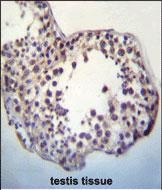TPTEa Antibody (N-term)
Affinity Purified Rabbit Polyclonal Antibody (Pab)
- 产品详情
- 实验流程
- 背景知识
Application
| WB, IHC-P, E |
|---|---|
| Primary Accession | P56180 |
| Reactivity | Human |
| Host | Rabbit |
| Clonality | Polyclonal |
| Isotype | Rabbit IgG |
| Calculated MW | 64322 Da |
| Antigen Region | 42-74 aa |
| Gene ID | 7179 |
|---|---|
| Other Names | Putative tyrosine-protein phosphatase TPTE, Cancer/testis antigen 44, CT44, Transmembrane phosphatase with tensin homology, Tumor antigen BJ-HCC-5, TPTE |
| Target/Specificity | This TPTEa antibody is generated from rabbits immunized with a KLH conjugated synthetic peptide between 42-74 amino acids from the N-terminal region of human TPTEa. |
| Dilution | WB~~1:1000 IHC-P~~1:100~500 E~~Use at an assay dependent concentration. |
| Format | Purified polyclonal antibody supplied in PBS with 0.09% (W/V) sodium azide. This antibody is purified through a protein A column, followed by peptide affinity purification. |
| Storage | Maintain refrigerated at 2-8°C for up to 2 weeks. For long term storage store at -20°C in small aliquots to prevent freeze-thaw cycles. |
| Precautions | TPTEa Antibody (N-term) is for research use only and not for use in diagnostic or therapeutic procedures. |
| Name | TPTE |
|---|---|
| Function | Could be involved in signal transduction. |
| Cellular Location | Membrane; Multi-pass membrane protein. |
| Tissue Location | Exclusively expressed in testis. |
For Research Use Only. Not For Use In Diagnostic Procedures.
Provided below are standard protocols that you may find useful for product applications.
BACKGROUND
Ubiquitin is a 76 amino acid highly conserved eukaryotic polypeptide that selectively marks cellular proteins for proteolytic degradation by the 26S proteasome. The process of target selection, covalent attachment and shuttle to the 26S proteasome is a vital means of regulating the concentrations of key regulatory proteins in the cell by limiting their lifespans. Polyubiquitination is a common feature of this modification. Serial steps for modification include the activation of ubiquitin, an ATP-dependent formation of a thioester bond between ubiquitin and the enzyme E1, transfer by transacylation of ubiquitin from E1 to the ubiquitin conjugating enzyme E2, and covalent linkage to the target protein directly by E2 or via E3 ligase enzyme. Deubiquitination enzymes also exist to reverse the marking of protein substrates. Posttranslational tagging by Ub is involved in a multitude of cellular processes, including the cell cycle, cell growth and differentiation, embryogenesis, apoptosis, signal transduction, DNA repair, regulation of transcription and DNA replication, transmembrane transport, stress responses, the immune response, and nervous system functions.
REFERENCES
Hattori, M., et al., Nature 405(6784):311-319 (2000).
Chen, H., et al., Hum. Genet. 105(5):399-409 (1999).
终于等到您。ABCEPTA(百远生物)抗体产品。
点击下方“我要评价 ”按钮提交您的反馈信息,您的反馈和评价是我们最宝贵的财富之一,
我们将在1-3个工作日内处理您的反馈信息。
如有疑问,联系:0512-88856768 tech-china@abcepta.com.























 癌症的基本特征包括细胞增殖、血管生成、迁移、凋亡逃避机制和细胞永生等。找到癌症发生过程中这些通路的关键标记物和对应的抗体用于检测至关重要。
癌症的基本特征包括细胞增殖、血管生成、迁移、凋亡逃避机制和细胞永生等。找到癌症发生过程中这些通路的关键标记物和对应的抗体用于检测至关重要。 为您推荐一个泛素化位点预测神器——泛素化分析工具,可以为您的蛋白的泛素化位点作出预测和评分。
为您推荐一个泛素化位点预测神器——泛素化分析工具,可以为您的蛋白的泛素化位点作出预测和评分。 细胞自噬受体图形绘图工具为你的蛋白的细胞受体结合位点作出预测和评分,识别结合到自噬通路中的蛋白是非常重要的,便于让我们理解自噬在正常生理、病理过程中的作用,如发育、细胞分化、神经退化性疾病、压力条件下、感染和癌症。
细胞自噬受体图形绘图工具为你的蛋白的细胞受体结合位点作出预测和评分,识别结合到自噬通路中的蛋白是非常重要的,便于让我们理解自噬在正常生理、病理过程中的作用,如发育、细胞分化、神经退化性疾病、压力条件下、感染和癌症。







